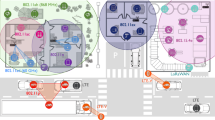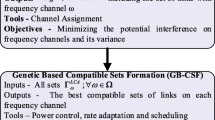Abstract
This paper presents an efficient scheme to optimize multiple layers in multi-hop wireless networks with throughput objectives. Considering channel sensing and power control at the physical layer, a non-convex throughput optimization problem is formulated for resource allocation and a genetic algorithm is designed to allow distributed implementation. To address link and network layers, a localized back-pressure algorithm is designed to make routing, scheduling, and frequency band assignments along with physical-layer considerations. Our multi-layer scheme is extended to cognitive radio networks with different user classes and evaluate our analytical solution via simulations. Hardware-in-the-loop emulation test results obtained with real radio transmissions over emulated channels are presented to verify the performance of our distributed multi-layer optimization solution for multi-hop wireless networks. Finally, a security system is considered, where links have their security levels and data flows require certain security levels on each of its links. This problem is addressed by formulating additional constraints to the optimization problem.






Similar content being viewed by others
Notes
The value of m should be set appropriately. If m is too small, sensing results may not be accurate enough; but if m is too large, the transmission stage is too short to achieve a large throughput. An appropriate value can be determined off-line by comparing the performance with different m values.
References
Alicherry, M., Bhatia, R., & Li, L. (2005). Joint channel assignment and routing for throughput optimization in multi-radio wireless mesh networks. In Proceedins of ACM MobiCom, Cologne, Germany, Augest 28–September 2.
Andrews, M., & Dinitz, M. (2009). Maximizing capacity in arbitrary wireless networks in the SINR model: Complexity and game theory. In Proceedings of IEEE INFOCOM, Rio de Janeiro, Brazil, April 19–25, pp. 1332–1340.
Bhatia, R., & Li, L. (2007). Throughput optimization of wireless mesh networks with MIMO links. In Proceedings of IEEE INFOCOM, Anchorage, AK, pp. 2326–2330.
Gao, C., Shi, Y., Hou, Y. T., & Kompella, S. (2011). On the throughput of MIMO-empowered multi-hop cognitive radio networks. IEEE Transactions on Mobile Computing, 10(11), 1505–1519.
Shi, Y., Hou, Y. T., Kompella, S., & Sherali, H. D. (2011). Maximizing capacity in multi-hop cognitive radio networks under the SINR model. IEEE Transactions on Mobile Computing, 10(7), 954–967.
Yuan, Y., Bahl, P., Chandra, R., Moscibroda, T., & Wu, Y. (2007). Allocating dynamic time-spectrum blocks in cognitive radio networks. In Proceedins of ACM MobiHoc, Montreal, Quebec, Canada, September 9–14.
Zhao, J., Zheng, H., & Yang, G. (2005). Distributed coordination in dynamic spectrum allocation networks. In Proceedings of IEEE DySPAN, Baltimore, MD, November 8–11, pp. 259–268.
Chen, C.C., & Lee, D.S. (2006). A joint design of distributed QoS scheduling and power control for wireless networks. In Proceedings of IEEE INFOCOM, Barcelona, Catalunya, Spain, April 23–29.
Dreo, J., Petrowski, A., Siarry, P., & Taillard, E. (2006). Metaheuristics for hard optimization: Methods and case studies. Berlin: Springer.
Tassiulas, L. (1995). Adaptive back-pressure congestion control based on local information. IEEE Transactions on Automatic Control, 40(2), 236–250.
Yackoski, J., Azimi-Sadjadi, B., Namazi, A., Li, J. H., Sagduyu, Y., & Levy, R. (2011). RF-NEST: Radio frequency network emulator simulator tool. In Proceedings of IEEE MILCOM, Baltimore, MD, November.
Cox, D. R., & Hinkley, D. V. (1974). Theoretical statistics. London: Chapman and Hall.
Wyglinski, A. M., Nekovee, M., & Hou, Y. T. (eds) (2010). Cognitive radio communications and networks: Principles and practices. Amsterdam: Elsevier.
Back, T., Fogel, D., & Michalewicz, Z. (eds) (1997). Handbook of evolutionary computation. New York, NY: Oxford University Press.
Acknowledgments
This material is based upon work supported by the Air Force Office of Scientific Research under STTR Contracts FA9550-12-C-0037, FA9550-10-C-0026 and FA9550-11-C-0006.
Author information
Authors and Affiliations
Corresponding author
Additional information
Any opinions, findings and conclusions or recommendations expressed in this material are those of the authors and do not necessarily reflect the views of the Air Force Office of Scientific Research.
Rights and permissions
About this article
Cite this article
Shi, Y., Sagduyu, Y.E. & Li, J.H. Multi-layer optimization with backpressure and genetic algorithms for multi-hop wireless networks. Wireless Netw 20, 1265–1273 (2014). https://doi.org/10.1007/s11276-013-0676-8
Published:
Issue Date:
DOI: https://doi.org/10.1007/s11276-013-0676-8




